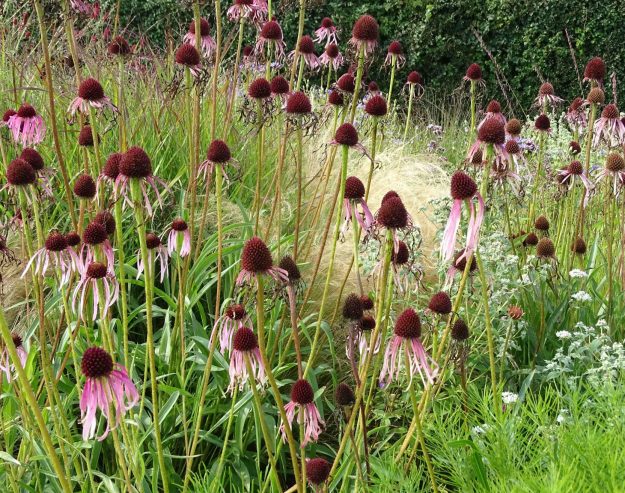
Echinacea, or coneflower in Oudolf Field, Hauser & Wirth, Somerset
Located in the tranquil Somerset countryside, Hauser & Wirth’s arts centre just outside Bruton is a destination both for modern art – and its gardens. Landscaping for the entire site has been designed by Piet Oudolf, and the Oudolf Field, described as a one acre perennial meadow, is its centrepiece.
Entering the Field, grass paths of varying widths weave through the dense planting, allowing visitors to experience the immersive effect of bold blocks of grasses and flowering perennials. Nearest to the gallery buildings is a concealed pond area which was attracting dragonflies on the day we visited in August, and at the top of the Field is a pavilion designed by Smiljan Radic.
Here in this meadow garden, created by one of the world’s best known landscape designers for an international art gallery, it seems like a good moment to consider the status of gardens as an art form. In that context, the Oudolf Field feels very much like a living installation.
The term ‘meadow’ suggests planting that is loose and informal, and this introduces an immediate conundrum for the visitor. The detail of Oudolf’s design is very tightly controlled, and while in August the overall effect of the mature planting is one of meadow-like irregularity, this belies a rigidity that underpins the design.
The perennial plants are placed and ordered with great precision – much as they might have been in a 17th century parterre. But unlike a parterre garden, this design is not symmetrical, and instead of being clipped into artificial patterns, the plants are chosen for their wilder character, and allowed to keep their natural shapes.
Beds edged with corten steel meet manicured grass or gravel pathways, providing the crisp edges we’d expect in a traditional formal garden. This contrast between formality and informality is one of the trademarks of Oudolf’s style, working best when all the elements are meticulously maintained – which is certainly the case at Hauser & Wirth and a great credit to the skill of their gardeners.
Oudolf uses lots of contrasts in his planting, and some of these create almost painterly effects. Hazy fine textured grasses are a favourite, as are the diffuse patches of green and yellow produced by perennial plants like Amsonia hubrichtii. This interesting plant carries small pale blue flowers in May and June on stems covered in fine needle-shaped leaves. These turn yellow and orange in autumn, providing intense splashes of colour amongst the paler grasses and forming a backdrop for flowers with an upright habit, such as veronicastrum and agastache.
In other areas, blocks of perennial flowers with rounded shapes like sedums (Hylotelephium), echinacea, helenium and various umbellifer species form a pleasing contrast with the flower spikes of persicaria, lythrum and perovskia.
Oudolf’s gardens are designed to reach their peak from late summer through autumn, and the plants are left to die back naturally – their structures providing winter interest and acting as a seedbank for birds. In February and March everything is cut back to ground level and the growth cycle begins again. Perhaps it is not intentional, but sculptor Richard Long’s Stone Circle (1980) located close to the pavilion seems to echo this circle of life theme.
Well worth a visit when travel becomes possible again – some links to Hauser & Wirth and Piet Oudolf’s website below:

Fine cut leaves of Amsonia hubrichtii turn from green to yellow in August, forming a hazy backdrop for late flowering upright spikes of pink veronicastrum and Eryngium agavifolium

Yellowing leaves of Amsonia hubrichtii form a striking contrast to the upright blue spike of agastache



Contrasting shapes of Hylotelephium (sedum) in the foreground with blue spikes of Perovski (Russian sage) directly behind

Detail Hylotelephium (formerly sedum)

Lythrum (centre) with Dianthus carthusianorum, or Carthusian pinks in the foreground



Contrast of texture and colour with purple Hylotelephium (sedum) in foreground, the yellow grass Carex elata ‘Aurea’ behind


Heleniums in flower

The pond at Oudolf field was attracting dragonflies on the day we visited. The flowering rush Butomus umbellatus in the foreground

Damera peltata, sometimes called the umbrella plant, in the pond area.

The Radic Pavillion

Plan of Hauser & Wirth, Somerset showing a simplified design of the Oudolf Field

Detail of corten steel edge to the borders juxtaposed with gravel and lawn


A large clump of yellow and orange heleniums provides a block of colour amongst the paler grasses and perennials

Oudolf’s design for the gallery courtyard. The late season grass Sesleria autumnalis brings a freshness to the planting
Further reading:




















